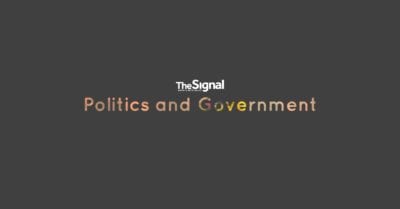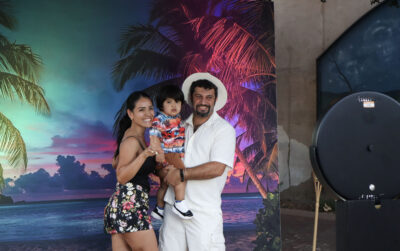By Emel Akan & Ryan Morgan
Contributing Writers
WASHINGTON — President Donald Trump welcomed Ukrainian President Volodymyr Zelenskyy and seven European leaders to the White House on Monday to explore paths to end Russia’s war with Ukraine.
During the meeting, Trump said the United States would help in providing security guarantees to Ukraine after the war to prevent any future aggression. He also said he would call Russian President Vladimir Putin to set up a followup meeting with both him and Zelenskyy as soon as possible to discuss the next steps.
The meeting followed Trump’s summit with Putin in Alaska on Friday.
“The Alaska summit reinforced my belief that, while difficult, peace is within reach,” Trump told European leaders.
The U.S. president first hosted a bilateral meeting with Zelenskyy at the White House before bringing in the European leaders for a larger meeting. Zelenskyy described the discussion as a “good conversation,” noting that the two leaders addressed sensitive issues, including security guarantees for Ukraine and proposals concerning which countries would control specific territories.
The Ukrainian leader said a further discussion about territorial control will take place in a trilateral meeting involving himself, Trump and Putin.
The European leaders who joined the larger multilateral meeting included British Prime Minister Keir Starmer, French President Emmanuel Macron, German Chancellor Friedrich Merz, Italian Prime Minister Giorgia Meloni, Finnish President Alexander Stubb, NATO Secretary-General Mark Rutte, and European Commission President Ursula von der Leyen.
Trump told the leaders that a breakthrough occurred at the Alaska summit when Putin agreed to accept security guarantees for Ukraine. He then emphasized the need to work out the specifics of the arrangement. He expressed hope that Europe would shoulder a large portion of the responsibility with the United States playing a supportive role.
“I’m optimistic that collectively, we can reach an agreement that would deter any future aggression against Ukraine,” Trump told the leaders.
“We also need to discuss the possible exchanges of territory taking into consideration the current line of contact,” the U.S. president said.
“Ultimately, this is a decision that can only be made by President Zelenskyy and by the people of Ukraine,” he added.
The leaders also expressed a shared hope for a peace deal in Ukraine.
Rutte said Trump’s willingness to support some form of security guarantee for Ukraine is a “big breakthrough.”
“I think in the past two weeks we’ve probably had more progress in ending this war than we have in the past three and a half years,” Stubb said. “And I think the fact that we’re around this table today is very much symbolic in the sense that it’s team Europe and team United States helping Ukraine.”
Trump earlier remarked on the unprecedented nature of the meeting with so many European leaders convening at the White House with such short planning.
“A big day at the White House,” Trump wrote on Truth Social on Monday. “We have never had so many European Leaders here at one time. A great honor for America!!!”
German Leader Presses for Cease-Fire
The Alaska summit failed to produce a cease-fire in the ongoing Russia-Ukraine conflict.
German Chancellor Merz pressed the issue during the White House meeting, stating that the credibility of future negotiations hinged on a cease-fire.
Ahead of the Alaska summit, Ukraine and European allies had said that any peace talks must take place under a cease-fire. Trump had also advocated for it, even warning Putin of “very severe consequences” if he refused.
However, since his meeting with Putin, the U.S. president said the “best way” to end the war in Ukraine is to move “directly” to a peace agreement.
Trump suggested that a cease-fire could emerge through a trilateral meeting involving both Zelenskyy and Putin.
“All of us would obviously prefer an immediate cease-fire while we work on a lasting peace, and maybe something like that could happen. As of this moment, it’s not happening,” Trump told European leaders.
However, the German chancellor urged that the next meeting — expected to be trilateral involving Putin — should produce a cease-fire.
Territorial Exchanges
Following the Alaska summit, Trump told Zelenskyy and European leaders that Putin demanded the Donbas region of eastern Ukraine as a condition for ending the war. In exchange, he offered to freeze the frontline in the southern regions of Kherson and Zaporizhzhia, two European sources familiar with the discussions confirmed.
The Donbas, made up of Luhansk and Donetsk provinces, has been the focal point of the conflict since 2014 due to its large Russian-speaking population. Currently, Moscow controls nearly all of Luhansk and roughly 70% of Donetsk.
When asked about Putin’s demand, Trump and Zelenskyy declined to comment directly about it. The Ukrainian leader said a further discussion about territorial control should be held with Putin without providing further details.
Zelenskyy earlier had said Ukraine would reject any proposal to cede the Donbas.
Security Guarantees
During a press conference after the Alaska summit, Putin said he agreed with Trump that Ukraine should have security guarantees once the war ends. He didn’t elaborate on what those security guarantees might look like, but said that the Kremlin is “prepared to work on that.
Ukraine has long sought membership in NATO — a goal Putin has strongly opposed. The Russian president has repeatedly accused the alliance of trying to expand along Russia’s borders.
U.S. special envoy Steve Witkoff said on Sunday that Putin agreed to allow the United States and European nations to provide Ukraine with “Article 5-like protection” as a security guarantee to bring an end to the war.
“We were able to win the following concession: That the United States could offer Article Five-like protection, which is one of the real reasons why Ukraine wants to be in NATO,” Witkoff said on CNN’s “State of the Union.”
It was “the first time we had ever heard the Russians agree to that,” he added.
Article 5 of the NATO Charter states that an attack against one member “shall be considered an attack against them all.”
New Warmth Between Trump, Zelenskyy
Half a year after their contentious Oval Office meeting, Trump and Zelenskyy struck a friendly tone with each other during the White House talks.
Trump greeted the Ukrainian president at the portico of the White House with a smile and a handshake.
During their bilateral meeting, the Ukrainian leader voiced appreciation to Trump for his wife Melania’s letter to Putin, which asked him to consider the innocence of children and to end the war.
Trump complimented the Ukrainian president on his black military-style suit. During their last Oval Office meeting, Zelenskyy did not wear a suit.
Zelenskyy’s previous meeting with Trump at the White House in February was cut short after the sit-down turned into a heated exchange, forcing the Ukrainian president to leave the meeting early.
This time, Zelenskyy arrived with European allies, including two who have recently grown close to Trump.
One of them was Finnish President Stubb, 57, who formed an unexpected bond with Trump after an unofficial visit to Mar-a-Lago in March. A former member of Finland’s national golf team, Stubb spent seven hours with the U.S. president, having meals and playing a round of golf.
The two leaders discussed “current foreign policy issues including Ukraine,” Stubb wrote on X on March 29. The Finnish president caught Trump’s attention by offering to supply icebreakers to the United States, highlighting Finland’s status as the world’s leading producer of these vessels.
Similarly, NATO Secretary-General Rutte has cultivated a strong relationship with Trump. At the NATO summit in the Hague in June, Rutte praised Trump’s leadership in pushing allies to ramp up defense spending and the U.S. president’s “decisive action” in dismantling Tehran’s nuclear capabilities.
During their bilateral meeting on June 25, Rutte likened Trump to a “daddy” who sometimes uses strong language to resolve disputes among his children. The remark went viral, and Rutte later clarified that he had been misunderstood by some critics who accused him of being overly flattering toward the U.S. president, saying that Trump is “a good friend” who “deserves all the praise.”
Jacob Burg, Jackson Richman, and Nathan Worcester contributed to this report.









